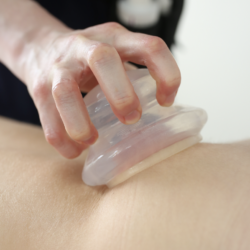
Cupping Therapy without the marks?
November 18, 2018 9:36 pmIt’s important to keep a close eye on the amount of pressure that each cup exerts on the body during cupping therapy. To ensure a more comfortable and controlled treatment, it’s recommended to use fewer cups rather than too many. By doing so, you can carefully regulate the level of pressure applied to the body.
Observing how the skin reacts to cupping therapy is crucial to ensuring the patient feels comfortable throughout the treatment. If you happen to notice excessive redness on the skin, it could be a sign that the treatment intensity is too high. Therefore, it’s recommended to be mindful of such signs and adjust the intensity level accordingly to ensure that the patient feels comfortable and safe.
After removing the cup, if you notice that any redness on the skin disappears within one minute, then it’s an indication that the suction created by the cup was appropriate. However, if the redness persists for more than one minute, then it’s likely that the suction was too aggressive. To minimize the chances of leaving cupping marks, it’s recommended to use the SFH Dynamic Cupping technique, which involves moving the cups. It’s essential to keep in mind that capillary membranes can only take a certain amount of pressure for a brief period before rupturing, which may result in bruising.
When the cups are left stationary, there is a higher chance of the skin developing discolorations. To minimize the risk of marking the skin, it’s recommended to use a gliding/massaging technique with the cups instead of leaving them in one spot for an extended period. This will ensure a more gentle and controlled treatment that is less likely to cause skin discoloration.
It’s recommended to avoid leaving the cup in a stationary position when performing cupping therapy on diabetic and pregnant women, as it can lead to sustained capillary pressure. To minimize the risk of adverse effects, it’s recommended to use a moving cup technique, which can help reduce the pressure on the capillaries.
The skin is highly responsive to the negative pressure created by cupping therapy and it can react almost instantly. It’s important to be prepared to reduce the cup suction pressure within the first 10 seconds of application to ensure a comfortable and safe treatment. Additionally, it’s recommended to never leave a cup unattended or use too many cups simultaneously on the body to avoid any adverse reactions or discomfort.
It’s crucial to avoid applying cups to areas where insulin injections have been administered in individuals with diabetes. The negative pressure generated by the cups can impede the effectiveness of the medication, leading to potential health complications. This can significantly compromise the health of the person with diabetes, and therefore, it’s highly recommended to avoid cupping in such areas.
It’s important to keep cups out of the reach of children as they can be hazardous if mishandled. Prolonged exposure to cups on the skin can lead to blistering, which can be painful and uncomfortable. Therefore, it’s crucial to keep children away from the cups to prevent any accidents or harm.
The SFH Dynamic Cupping online and in-person courses provide comprehensive coverage of the risks and safety measures involved in cupping therapy to ensure a professional and safe treatment for both the therapist and the client. At our training facility, we prioritize the well-being of both the therapist and the clients and strive to provide a safe and comfortable environment for all.
Happy SFH Dynamic Cupping!
Click here to view the online course
Click here to view in-person course dates
Tags: Cupping marksCategorised in: Certification, SFH Dynamic Cupping
This post was written by Linda Hoppe
Comments are closed here.